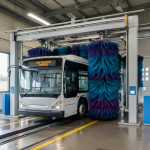Keeping fleet vehicles clean is essential for not only maintaining a professional image but also ensuring their longevity. However, the costs associated with cleaning a fleet of tractor-trailers and buses can quickly add up. That’s why finding cost-saving strategies is crucial for any fleet owner or manager. In this article, we will explore five effective ways to reduce fleet tractor-trailer and bus cleaning expenses without compromising on cleanliness and hygiene. Whether you’re running a transportation company or managing a fleet for a logistics business, these strategies can help you optimize your budget while keeping your vehicles spotless. From implementing efficient cleaning schedules to training your staff on proper cleaning techniques, we will provide practical tips and insights to help you reduce costs and streamline your vehicle cleaning process. By following these strategies, you can enhance your fleet’s overall appearance, improve your bottom line, and ensure that your vehicles leave a positive impression on the road.
Understanding the expenses involved in fleet tractor-trailer and bus cleaning
Maintaining a fleet of tractor-trailers and buses involves various expenses, and cleaning is one of the significant costs. By implementing cost-saving strategies, fleet owners and managers can optimize their budget while keeping their vehicles spotless. Not only does this approach enhance the fleet’s overall appearance, but it also improves the bottom line and ensures that the vehicles leave a positive impression on the road.
Before diving into cost-saving strategies, it’s important to understand the expenses involved in fleet tractor-trailer and bus cleaning. These expenses include labor costs, chemical expenses, supply management costs, and potential long-term expenses for equipment maintenance and replacement. By identifying these cost components, fleet owners and managers can focus on areas for improvement and implement effective strategies to reduce overall cleaning expenses.
Assessing current cleaning processes and identifying areas for improvement
To reduce cleaning expenses, it’s crucial to assess the current cleaning processes and identify areas that can be improved. This evaluation includes reviewing the cleaning schedule, evaluating cleaning techniques, and examining the efficiency of the cleaning staff. By identifying any inefficiencies or gaps in the current cleaning processes, fleet owners and managers can develop targeted strategies to streamline operations and reduce labor costs.
Implementing efficient cleaning practices to reduce labor costs
One of the significant expenses in fleet cleaning is labor costs. By implementing efficient cleaning practices, fleet owners and managers can optimize labor utilization and reduce costs. This can be achieved by developing a well-structured cleaning schedule, ensuring that the cleaning staff is trained in proper cleaning techniques, and implementing time-saving tools and equipment. By streamlining the cleaning process, fleet owners and managers can reduce labor costs without compromising on cleanliness and hygiene.
Utilizing eco-friendly cleaning products to reduce chemical expenses
Chemical expenses can also contribute significantly to fleet cleaning costs. By switching to eco-friendly cleaning products, fleet owners and managers can reduce chemical expenses while maintaining high cleaning standards. Eco-friendly products not only minimize the impact on the environment but also tend to be more cost-effective in the long run. By choosing environmentally friendly options, fleet owners and managers can reduce chemical expenses and contribute to a greener and sustainable cleaning process.
Streamlining supply management to minimize costs
Supply management is another aspect that can impact fleet cleaning expenses. By streamlining supply management, fleet owners and managers can minimize costs and reduce wastage. This can be achieved by implementing an effective inventory management system, monitoring supply usage, and negotiating favorable contracts with suppliers. By optimizing supply management, fleet owners and managers can ensure that cleaning supplies are efficiently utilized and costs are minimized.
Investing in automated cleaning equipment to improve efficiency and reduce long-term expenses
While the initial investment may be higher, investing in automated cleaning equipment can significantly improve efficiency and reduce long-term cleaning expenses. Automated equipment, such as power washers and automated bus wash systems, can save time, reduce labor costs, and improve cleaning effectiveness. By investing in such equipment, fleet owners and managers can achieve long-term cost savings while maintaining high cleaning standards.
Training and empowering cleaning staff to optimize productivity and reduce turnover costs
Well-trained and empowered cleaning staff can significantly impact productivity and reduce turnover costs. By investing in proper training programs and providing opportunities for skill development, fleet owners and managers can optimize staff productivity and reduce the need for frequent recruitment and training. This not only reduces turnover costs but also ensures that the cleaning staff is equipped with the necessary skills to perform their tasks efficiently.
Monitoring and tracking cleaning expenses to identify potential areas for further cost reduction
To continuously improve cost-saving strategies, it’s essential to monitor and track cleaning expenses. By analyzing expenditure patterns and identifying potential areas for further cost reduction, fleet owners and managers can refine their strategies and achieve even greater savings. Regularly reviewing cleaning expenses allows for adjustments and fine-tuning of cost-saving initiatives, ensuring that fleet cleaning operations remain efficient and cost-effective.




